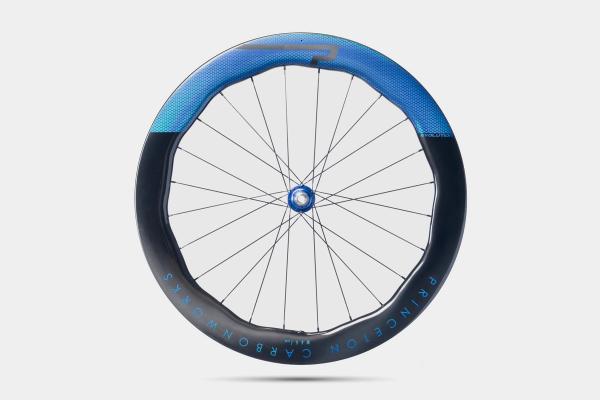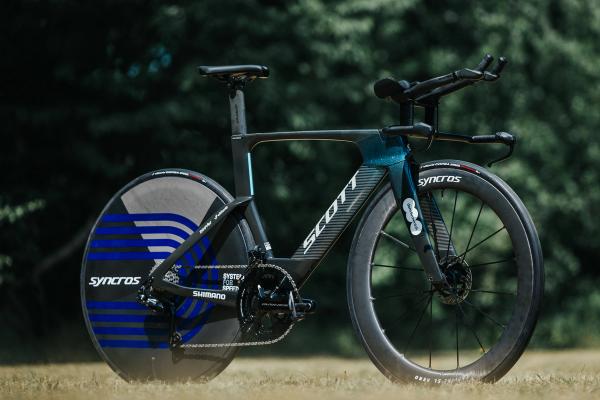What do bike geometry terms really mean?
Bike geometry can be an overwhelming topic but here we explain all the key terms and exactly what they mean
Alex Hunt
Junior Tech Writer
© GCN
Bike geometry can be confusing, but it is important to bear in mind when looking for your next bike
The angles that make up a bike frame are way more important than defining just how a bike looks. They affect the way a bike handles and what position the rider sits in.
Bike geometry can seem daunting, but it's worth getting to grips with the terms manufacturers use, as well as getting an understanding of how they can affect the feel of a bike.
In recent years the geometry of bikes has become a key part of how bikes are marketed. The development of gravel bikes in particular has brought geometry to the forefront. Stack, reach, head angle; there are so many terms that get bandied around, and to find a bike that's right for you, you need to know what they mean.
Read on for our handy guide on how the angles and measurements of a bike will change how it rides.
What is a bike's head angle?
Starting at the front of the bike is the head angle. This is the angle that the steerer tube sits at from the horizontal plane. This means if a bike had a vertical head angle, the figure would be 90 degrees. When people talk about a 'slack' head angle, they mean that this angle is lower than usual, and the fork is pointed further forward.

© Canyon
The head angle of a bike both affects the wheelbase and the responsiveness
The head angle of a bike controls how the bike feels at speed, how it rides on looser surfaces, and how responsive rider inputs are. Put simply, a slacker head angle makes a bike feel more stable, whereas a steeper head angle makes a bike more agile. This is the case because of how your wheel interacts with the ground; with a steeper head angle, more of the rider's steering input is translated into turning the tyre on the ground. Road bikes have steep head angles, gravel bikes slightly slacker, and mountain bikes slacker still.
Is seat tube angle something to look into?
As with head angle, the figure for a bike seat tube angle comes from its angle relative to the horizontal plane. The seat tube angle of a frame is very important in how well a bike sizes across its intended rider range.
As a rider requires a higher saddle height, it is safe to assume that they will also need an increase in reach as riders with longer legs will also typically have a longer torso. Getting the right angle for the seat post will allow the reach of the bike to grow in line with an increased saddle height. Get the seat tube angle too steep and taller riders will have to start fitting longer and longer stems to get the bike to fit. Equally, a very slack seat tube angle will mean that the bike will not fit riders as the saddle height increases as the reach becomes unmanageable.
How does reach affect how a bike feels?
The reach of a bike is the horizontal distance between the bottom bracket and the top of the head tube. This will define how roomy the bike feels. This is a good measurement to remember when comparing bikes as a bike with a comparable reach will fit similarly. This does not mean that it will ride the same or have the same characteristics as this is affected by the other areas of bike geometry.
.jpg?w=1348&auto=format)
© GCN
A bike's reach is defined as the horizontal measurement between the bottom bracket and the head tube
In the gravel world, there has been a trend in recent years for bikes to have longer and longer reaches for any given size. In the main, this is to allow riders to fit shorter stems without compromising on bike fit.
Read more: Changes in bike position prevent Froome from performing at Israel-Premier Tech
The importance of stem length
Stem length is the length of the stem, the component that attaches your handlebars to the steerer tube of your fork. With the changes in bike geometry mentioned above, bikes needed some way of keeping them feeling responsive as well as fitting a rider properly. This is where stem length comes in. For a lot of bikes at the more adventurous end of the spectrum, such as gravel and endurance bikes, the stems that come fitted as standard have been shrinking.

© GCN
Shorter stems are now coming as standard on endurance and gravel bikes to compensate for the increase in reach
With the slacker head angles, using a long stem would make the front of the bike feel very lazy and would require big inputs from the rider in order to get it to change direction. It may feel composed at very high speeds but at the cost of how agile it could be in other situations. When the increases in frame reach are factored in the natural answer to bring all of this together is to reduce the stem length.
- Read more: Should all cyclists get a bike fit?
By reducing the length of a stem you can keep the overall reach from the bottom bracket to the hoods of the bars the same even though the frame is longer. It also has the benefit of tightening up the steering feel of the bike with shorter stems feeling more responsive than longer ones.
What is meant by stack?
Stack is the vertical distance between the bottom bracket and head tube. The stack height of a bike can give you an insight into how racy a bike's position is going to be. The lower the stack height is, the lower your bars will be, and the lower you'll have to bend your body.
Endurance bikes typically have a greater stack height, which gives them a taller front end, so the rider sits in a more relaxed and upright position.
Although stack height can be tuned with headset spacers, it is always best to find a bike that closely fits the range you need. If you do not find bikes with a low stack height comfortable to ride, there's no point buying one to then jack the bars up with lots of spacers. Not only is this not exactly an aesthetic look, it also affects the reach of the bike and by extension the fit of the bike as well.
Is seat tube length worth considering?
The seat tube is the tube of your frame that runs from the bottom bracket to your seatpost. Traditionally, this was the figure used to measure bike frame sizes. However, modern bike frames do not comply to the traditional double-diamond, horizontal top tube design, so the seat tube length doesn't tell us much about how a bike fits any more.
On modern bikes, the seat tube length can impact how comfortable a bike is. A bike with a shorter seat tube will leave more seatpost exposed above the frame, giving greater compliance. This is something we commonly see on endurance bikes as this allows for more flex and therefore comfort, isolating the rider from road buzz and high-frequency chatter.
Finally, a shorter seat tube will give a lower standover height, which might make a bike easier to mount and dismount.
What is top tube length and does this matter?
You might be caught thinking that top tube length is a fairly simple figure, being the length of the top tube of the bike. Like most things in cycling the answer isn’t quite that simple.
On a traditional style road bike with a horizontal top tube, this is the case, but as soon as we look at bikes with what is known as compact geometry - that has a sloping top tube - this changes. On bikes like this, we need to look at a figure called an effective top tube. Instead of measuring how long the actual tube is, this figure calculates how long the top tube would be if it were horizontal.

© GCN
It is important that for bikes with an effective top tube measurement quoted that this is used rather than the actual measurement
The top tube of a bike is the ultimate determining factor in a bike's reach. There is only so much that can be compensated for with a change of stem length and a bike with too long of a top tube will put a lot of strain on the rider's core and arms.
Does chainstay length really matter?
Chainstay length is the measurement between the dropouts for the rear wheel and the bottom bracket. On racy-feeling bikes you want to keep the chainstays as short as possible. This will reduce the overall wheelbase of the bike but also make it snappier through turns and more nimble.
.jpg?w=1348&auto=format)
© Canyon
A shorter wheelbase will make a bike feel more responsive ideal for a race bike
Road bikes intended for racing will generally have shorter chainstays, whilst endurance bikes will usually have slightly longer chainstays.
Often, manufacturers are forced to increase the chainstay length so they can make room for larger tyres. As more and more gravel bikes make room for tyres of 50mm or more, chainstay lengths have started to expand.
Do I need to be concerned about bottom bracket drop or height?
Bottom bracket drop is the difference between the height of the bottom bracket and the axles of the wheels. The more BB drop a frame has, the more stable it will feel as the lower the rider's centre of gravity will be. A bike with a low bottom bracket almost feels like you're sitting in the bike, rather than perched on top.
A bike with a significant BB drop will handle like it is on rails. However this is only one-half of the bottom bracket equation.
Although a lower BB might improve the handling of a bike it does also reduce the clearance with the ground. This means that a bike with a low BB height can cause issues when it comes to pedalling through turns or clipping obstacles whilst riding off-road.
Where does crank length fit into the puzzle?
If you look to the professionals, crank length is a new area under investigation. As bikes look to exploit lower BBs with more exaggerated drops, one of the ways the issue of crank clearance can be compensated is by using shorter cranks. They also have the effect of being slightly more aero by exposing less of the thigh to the wind through a slightly reduced maximum hip angle, as well as allowing for snappier accelerations.

© GCN
Shorter crank lengths can give the rider more pedal clearance as well as allow for better pedalling dynamics at higher cadences
Tom Pidcock and Tadej Pogacar have both reportedly been trialling 165mm cranks with Pidcock looking to try 160mm on his time trial bike. This is an area that is still being tested however going shorter does buck the previous assumption that longer is better as it provides more leverage.
- Read more: Tom Pidcock leans into bike tech science with low tyre pressure and shorter crank length
How much does the wheelbase of a bike affect how it rides?
The wheelbase of a bike is the distance between both axles. The shorter a wheelbase, the snappier and racier a bike will feel. As the wheelbase grows the bike will begin to feel more composed and controllable at higher speeds. Generally, the wheelbase of the bike will be dictated firstly by the size of the frame that fits you and secondly by the style of riding you want.
Does frame size affect the geometry and handling of a bike?
Some brands, namely Specialized, use a manufacturing technique called rider-first engineering. This is where each frame size is designed individually to retain the same ride characteristics. This might mean that on larger frames they are slightly more reinforced than on smaller frames. This is to create the same feel to the rider, regardless of size.
For a lot of other bike manufacturers, this is not the case and each frame size features the same design and material characteristics. This does mean that the further you stray away from the default size (typically a 56cm frame for road bikes) the more likely it is that smaller frames can start to feel harsh and larger frames can start to feel a bit more flexible.
- Read more: Do we really need women’s-specific bikes?
Something else to consider is that different bike sizes can typically have modified geometry across the size range. This is to compensate for things such as toe overlap, which can be a real issue on bikes with shorter reaches. In order to adjust for this, smaller bikes tend to have a slacker head angle to push the front wheel that little bit further out in front.
What this means is that if you can fit on two sizes of bikes, which is fairly common for a lot of riders, you can pick the one that suits the riding characteristics you most prefer. The key to finding the right bike is to know how to interpret a manufacturer's geometry chart.
If you have ridden a bike that you like the feel of and felt that it managed to strike the perfect blend between ride performance and fit then it is always good to use the geometry figures of this bike as a good base point for comparison. A website like Geometrygeeks makes comparing bikes pain-free and shows the differences between selected models.
For more tech features make sure to head over to our dedicated tech section of the GCN website.














